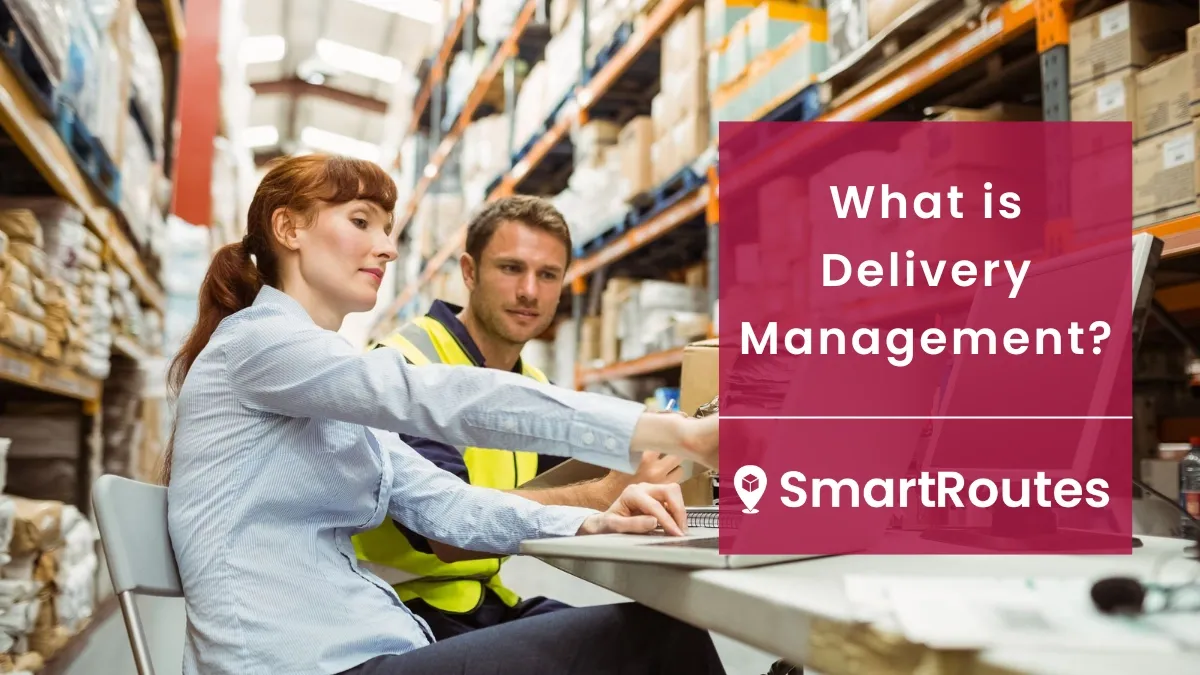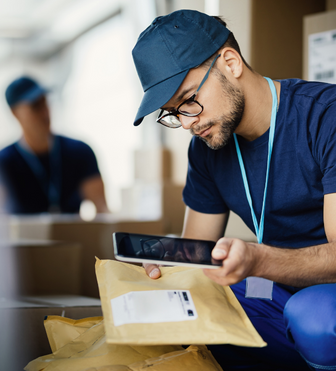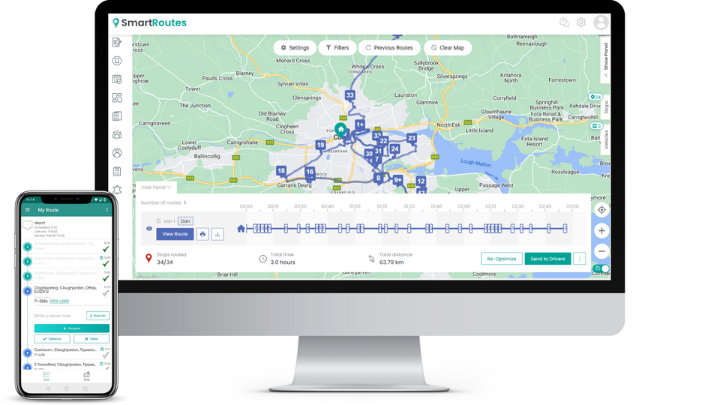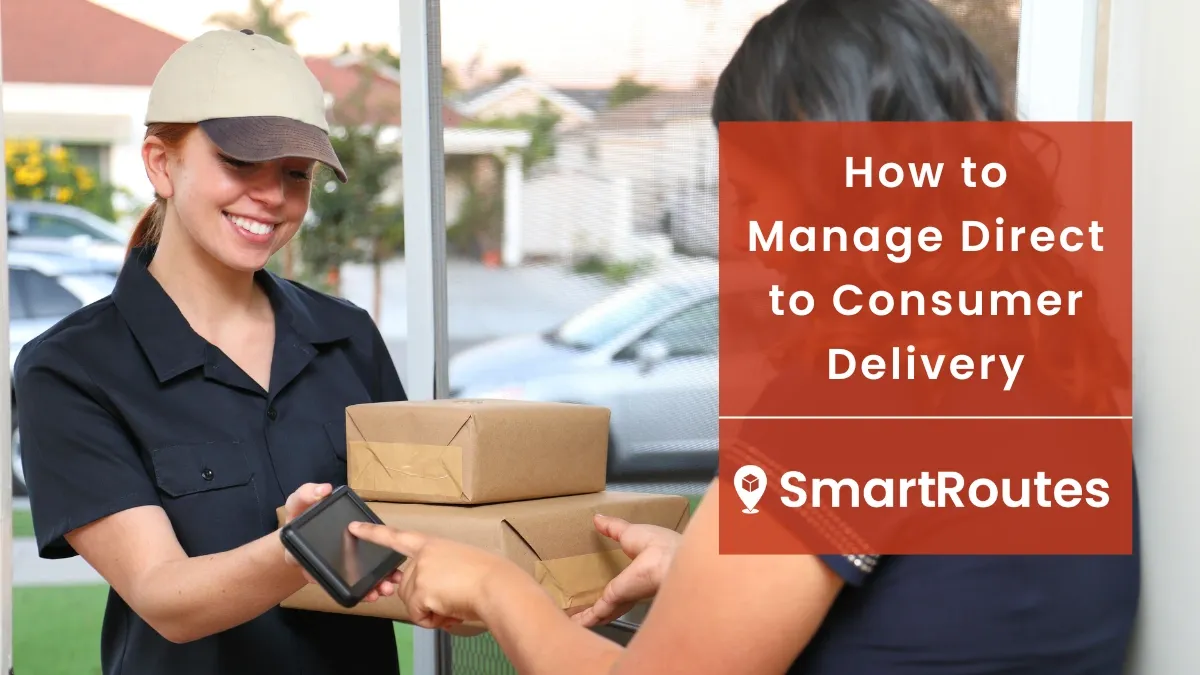What is Delivery Management? The Complete Guide
Learn exactly what delivery management is plus discover key strategies and essential software features.

With eCommerce sales expected to surpass 1.3 trillion USD by 2028, ensuring that you can deliver goods efficiently should now be a priority for your business. The explosive growth of online shopping has made delivery services a critical component of customer satisfaction and overall business success. From small local businesses to large global retailers, offering timely and reliable deliveries is no longer just a competitive advantage—it's a necessity.
Whether you're a small business owner looking to expand your reach or a large retailer aiming to streamline your logistics, effective delivery management can make a significant difference. By implementing the right strategies and tools, you can ensure that your goods are delivered on time, every time.
That’s why we’ve created this comprehensive guide. We will cover the basics of delivery management, its impact on your business profitability, driver happiness, and customer satisfaction.
Who is in Charge of Delivery Management?
Why is Delivery Management Important?
How to Measure Delivery Management Performance
How to Improve Delivery Management
What is Delivery Management?
Delivery Management refers to the comprehensive process of overseeing last mile deliveries, which involves transferring goods from a warehouse or store to their final destination as efficiently and effectively as possible. This crucial stage of the supply chain is often considered the most complex and costly, yet it is pivotal in ensuring customer satisfaction and operational success.
Delivery Management encompasses several key functions, including:
- Dispatch Management: This involves coordinating the assignment of orders to drivers, ensuring that each delivery is dispatched in a timely and organized manner.
- Delivery Routing: This function focuses on planning the optimal routes for delivery vehicles. Effective routing minimizes travel time and distance, reduces fuel costs, and ensures timely deliveries.
- Delivery Fleet Management: This includes managing the entire fleet of delivery vehicles, from maintenance and fuel management to tracking vehicle locations and performance.
In essence, Delivery Management aims to make the delivery process as smooth, cost-effective, and timely as possible. This involves balancing multiple variables such as delivery windows, vehicle capacity, traffic conditions, and driver availability. By optimizing these elements, businesses can enhance their operational efficiency, reduce costs, and improve customer satisfaction.
SmartRoutes Delivery Management Software
Streamline your entire delivery process, all from one platform

Who is in Charge of Delivery Management?
The responsibility for delivery management typically falls on logistics managers, dispatch managers, and fleet managers. These roles, while varied in their specific duties, collectively aim to organize and streamline the delivery process, ensuring that it is efficient and meets customer expectations.
Logistics managers oversee the entire supply chain, from procurement to delivery, ensuring that goods flow efficiently and cost-effectively. Dispatch managers focus on coordinating and assigning delivery tasks to drivers, monitoring progress, and maintaining communication to address any issues promptly. Fleet managers are responsible for the upkeep and management of delivery vehicles, ensuring they are well-maintained, fuel-efficient, and compliant with safety regulations.
Effective delivery management often requires a collaborative effort among these roles, leveraging advanced delivery management software to aid in real-time data tracking, automated route planning, and efficient dispatching. This integration of technology allows managers to focus on strategic planning, ultimately enhancing delivery efficiency and reliability. The common goal for all involved is to maximize efficiency, reduce costs, and ensure a high level of customer satisfaction.
Why is Delivery Management Important?
Delivery management software can significantly enhance delivery operations, here are some of the benefits of using delivery management systems:
- Timely Delivery: Efficient route management is crucial for identifying the most cost-effective and timely routes. Delivery management software accounts for multiple variables such as the number of stops, specific time windows for deliveries, vehicle capacity, and driver availability.
- Productivity: Delivery software software boosts fleet productivity by enabling more deliveries with fewer resources. Automated dispatching and scheduling streamline the planning process, saving significant time for delivery planners.
- Profitability: The last mile is widely recognized as the most expensive part of the delivery journey. Optimizing routes reduces the cost per delivery by minimizing travel distances and fuel consumption. Additionally, fewer missed deliveries mean fewer re-deliveries, which saves both time and money.
- Customer Retention: Timely deliveries and real-time tracking links significantly enhance the customer experience. Delivery notifications provide customers with accurate updates about their deliveries. Even when unforeseen delays occur, keeping customers informed helps maintain their satisfaction and trust.
- Delivery Operations Oversight: Real-time data provides comprehensive insights into fleet whereabouts and driver performance. This visibility enables dispatch coordinators to respond quickly to any issues, answer customer inquiries efficiently, and monitor route progress. Additionally, managers can track adherence to planned routes and performance metrics, allowing for continual improvement in delivery operations.
By integrating last mile delivery management software, businesses can achieve these benefits, ensuring that their delivery operations are efficient, cost-effective, and customer-focused.
How to Measure Delivery Management Performance
To ensure your delivery management process is effective, it’s crucial to measure key performance indicators (KPIs). These metrics help assess the efficiency and effectiveness of your delivery operations, providing insights into areas for improvement.
Assess Driver Performance
Monitoring driver performance is essential for maintaining an efficient delivery operation. Key aspects to track include adherence to routes, timeliness, and delivery sequence. Ensuring drivers follow the planned routes helps avoid unnecessary delays and additional costs. Tracking how punctual drivers are in making deliveries within the scheduled time windows is also important. Additionally, verifying that deliveries are made in the correct order optimizes efficiency and meets customer expectations.
Measure On-Time Delivery Rate
The on-time delivery rate is a critical indicator of your delivery reliability. To measure this, track the time each delivery is completed and compare it to the scheduled delivery window. Analyzing the data helps identify common causes of delays, such as traffic issues, route inefficiencies, or driver performance. You can adjust routes, schedules, and processes to enhance your on-time delivery rate.
Assess Route Efficiency
To evaluate route efficiency, compare planned routes with actual routes taken by drivers and assess whether deviations are causing inefficiencies. Analyzing return rates is also crucial; frequent returns with undelivered packages may indicate issues with route planning or delivery execution. If manual route planning leads to frequent delays, investing in automated route optimization software can help create more efficient and reliable routes.
Measure Customer Satisfaction
Regularly collecting customer feedback through surveys, reviews, and direct communication helps understand their delivery experience. Monitoring delivery-related complaints helps identify recurring issues and areas for improvement. Automating notifications and providing live estimated times of arrival (ETAs) keep customers informed about their deliveries, reducing anxiety and improving satisfaction.

How to Improve Delivery Management
There are several options on the market but the top delivery management software will include following features:
Route Planning & Optimization
Efficient route planning and optimization are critical components of effective delivery management. Last mile delivery software is equipped to handle a range of complex variables, ensuring that every delivery is executed as efficiently as possible. Variables such as specific delivery windows that customers request, priority shipping that requires expedited handling, and the coordination of two-person delivery teams for larger items. The software takes these factors into account to develop routes that meet all necessary conditions while optimizing efficiency.
Efficient route planning and optimization ensure that deliveries are completed promptly and cost-effectively. The primary financial benefit of route optimization is the substantial savings on fuel and operational costs. Additionally, by reducing the likelihood of delays and missed deliveries, the software enhances overall service reliability. Customers receive their orders on time, leading to increased satisfaction and loyalty. Businesses can then allocate resources more effectively, reinvesting savings into other areas of the operation or passing savings onto customers through competitive pricing.
Automated Scheduling & Dispatching
Integrating your online store with delivery management software revolutionizes the route scheduling and dispatching process by automating many of the tasks that traditionally require manual intervention. With this integration, orders can be automatically pulled from your store as soon as they are placed. This includes critical details such as product quantities, delivery addresses, and customer contact information.
Once the order details are in the system, the software generates optimized routes for the deliveries. Delivery scheduling software considers various factors to create the most efficient routes possible. These optimized routes ensure that deliveries are made in the quickest and most cost-effective manner. After generating the routes, the software automatically dispatches them to the drivers. This automated dispatching process eliminates the need for a dedicated dispatcher to manually assign routes and communicate them to drivers. Instead, drivers receive their routes directly on their mobile devices, complete with all necessary details and navigation instructions.
Vehicle Tracking
Real-time fleet tracking is a critical feature of advanced delivery management systems, offering a comprehensive overview of your delivery operations. This technology provides accurate, live ETA updates, enabling businesses to manage delays effectively and ensure that workloads are evenly distributed among drivers.

Real-time tracking allows dispatchers to monitor the exact location of each vehicle in the fleet at any given moment. Accurate live ETA updates are another major benefit of real-time vehicle tracking. Customers today expect to know exactly when their delivery will arrive. Providing them with real-time tracking links and precise ETAs improves their overall experience. If there are any delays, customers can be promptly informed, which helps manage their expectations and reduce frustration.
Driver Mobile App
By centralizing all necessary tasks within a single application, driver mobile apps reduces the administrative burden on drivers, allowing them to focus on making efficient deliveries. One of the key benefits of using an app to manage deliveries is route navigation. With integrated GPS functionality, drivers receive turn-by-turn directions to each delivery location.
Digital manifests are another important feature. Instead of handling physical paperwork, drivers can access all delivery details through the app. This includes the list of packages, recipient information, special delivery instructions, and priority levels. Digital manifests streamline the process, reduce the risk of losing important documents, and make it easier for drivers to stay organized.
Automated Notifications
Keeping customers informed throughout the delivery process is crucial for ensuring a positive experience, and automated notifications play a vital role in achieving this goal. By leveraging SMS and email communications, businesses can provide customers with real-time updates, enhancing transparency and trust.
Automated notifications are designed to keep customers apprised of their order status at every stage of the delivery journey. From the moment an order is dispatched, customers receive real-time tracking links that allow them to monitor the progress of their delivery. These links provide detailed information, such as the current location of the delivery vehicle and the estimated time of arrival (ETA). This level of visibility helps manage customer expectations, as they can plan their day around the delivery and reduce anxiety about when their orders will arrive. By knowing when to expect their delivery, customers can make necessary arrangements to receive their packages, whether that means being at home or providing specific instructions for where the package should be left. This proactive communication reduces the likelihood of missed deliveries and the inconvenience they cause.
Reporting and Analytics
Robust reporting and analytics tools within delivery management software are indispensable for evaluating and improving your delivery operations. These tools provide comprehensive insights into various aspects of the delivery process, enabling you to make data-driven decisions that enhance efficiency, customer satisfaction, and overall business performance.
One of the primary benefits of reporting and analytics is the ability to track key performance metrics. By consistently monitoring delivery times, you can identify patterns and trends that might indicate areas for improvement. Route efficiency is another critical metric that can be analyzed through these tools. Inefficient routes not only waste time but also increase fuel consumption and operational costs. Analytics can reveal which routes are underperforming and why, whether due to poor planning, traffic conditions, or other factors. With this information, you can optimize routes to ensure that deliveries are made in the most time- and cost-efficient manner possible.
By implementing delivery management software with these features, you can significantly enhance your operations. The benefits include reduced costs, increased efficiency, improved customer satisfaction, and a competitive edge in the market.
Choosing the Right Delivery Management Platform for your Business
Implementing a solid delivery management system is more straightforward than you might think. These tools can be quickly integrated, transforming the delivery process from manual and time-consuming to efficient and automated.
By adopting a delivery management platform, you can scale your operations, add vehicles and drivers with ease, and forecast future profitability confidently. It helps you plan effectively and creates a clear vision for your team.
Ready to optimize your delivery routes? Start a 7-day free trial with SmartRoutes and take your delivery operations to the next level.
Frequently asked questions
1. What is Delivery Management?
Delivery management refers to the comprehensive process of overseeing and optimizing the entire delivery process, from order fulfillment to the final delivery destination. It involves planning and coordinating logistics, routes, vehicles, and personnel to ensure efficient and timely delivery of goods or services to customers.
2. How can I improve my delivery operations and reduce costs?
There are several ways to improve delivery operations and reduce costs, including implementing delivery management software, optimizing delivery routes, automating scheduling and dispatching processes, monitoring driver performance, and leveraging data analytics to identify inefficiencies and areas for improvement. By streamlining processes, reducing unnecessary mileage, and enhancing overall efficiency, businesses can lower operational costs while improving the quality of their delivery services.
3. What is delivery management software?
Delivery management software is a technological solution designed to streamline and optimize various aspects of the delivery process. It typically includes features such as route planning and optimization, automated scheduling and dispatching, real-time tracking and monitoring, driver mobile applications, automated notifications, and reporting and analytics tools. Delivery management software helps businesses manage their delivery operations more efficiently, reduce costs, improve customer satisfaction, and gain insights into performance metrics.
4. What is a delivery manager?
A delivery manager is a professional responsible for overseeing and managing the delivery operations of a company or organization. Their role involves planning and coordinating delivery schedules, optimizing delivery routes, managing fleet vehicles and drivers, ensuring compliance with regulations and safety standards, and resolving any issues or challenges that arise during the delivery process. Delivery managers play a critical role in ensuring that deliveries are completed efficiently, on time, and within budget.
If you enjoyed this blog, you might also be interested in:







